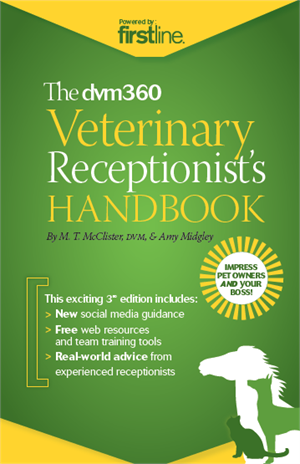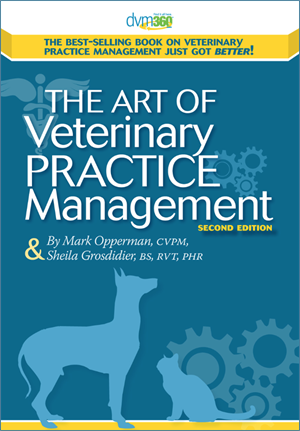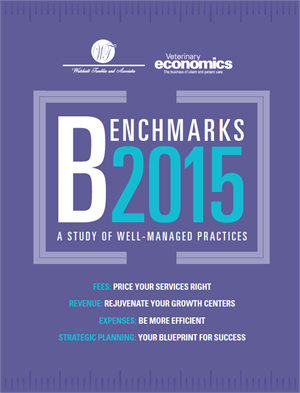Read! Books you need!
In which we shamelessly self-promote our books by pointing out how we've thought through your biggest problems and solved them ALL (mostly). (Note: We're giving away free content from the book here. Really. Like scheduling tools, employee incentive programs and more.)

I need to train my receptionist!
Of course you do. And good on ya for realizing this. You're halfway here. Here's the kind of advice and tools you'll find in the recently revised dvm360 Veterinary Receptionist's handbook, Third Edition:
Scheduling well pet services
Filling out an appointment-times chart gives you a good idea how long a wellness exam with vaccinations will take. But that's only part of what you need to know.
When a client calls for a wellness exam, ask whether the pet is having any problems that need the doctor's attention. If a pet has an allergy, for example, a routine 20-minute appointment could easily stretch into 40 minutes. So try to determine everything that needs to be done while the pet is at the clinic.
Time allotment for clinic services
Purpose of visit Schedule in a.m. p.m. Minutes to allow
Special instructions
Wellness exam (dog)
Wellness exam (cat)
First puppy visit
First kitten visit
Follow-up puppy visits
Follow-up kitten visits
Exam-sick pet
Doctor release surgery
Doctor release hospitalized pet
Suture removal
Clip nails
X-ray
Heartworm check only
Fecal check only
FeLV test only
Bath
Other (specify):

I need help motivating my team!
Better business means you can practice better medicine, amiright? But first you've got to get your team motivated. Check out this advice from the recently revised Art of Veterinary Practice Management, Second Edition:
Incentive programs
In a well-established practice, you can put 10 percent of the increase of gross from one quarter-as compared to the same quarter of the previous year-into an employee incentive fund. At the end of each quarter, ask employees to evaluate themselves. The owner or manager will also evaluate each employee.
Give each completed evaluation a numerical value, anywhere between 0 and 100 percent. Adjust the scores based on the number of hours the employee worked. For example, say an employee gets an 80 percent but worked 20 hours a week. You'll convert that 80 score to a 40 because the employee worked half the hours of a full-time employee. Divide the adjusted figure into the fund to determine how much each employee receives. Say you have $1,000 in the fund and two employees. One received a 60 percent score and the other received a 40. You'd give $600 to the higher scoring employee and $400 to the other.
The VMC Inc. Employee Incentive Program
Here's how ABC Animal Hospital determines its bonuses using the VMC Inc. Employee incentive program.
1. Determine employee bonus fund amount
Gross income this quarter $110,000
Less prior year's gross income for same quarter -$105,000
Equals increase in gross income for same quarter $5,000
Multiply by 10% x 0.10
Total employee bonus fund $500
2. Determine bonus fund value per share
A. Total the evaluation scores for all the practice's full-time employees.
70 (Judy) + 80 (Jackie) + 100 (Claire) = 250
B. For all part-time employees, take the average number of hours worked and divide by 40 (a full-time week). Multiply this by the employee's evaluation score to determine the adjusted evaluation score.
17.5 hours worked / 40 = 0.4375
0.4375 x 80 = 35 (April's adjusted evaluation score)
C. Total all evaluation points scored by full-time and part-time employees.
250 + 35 = 285
D. Divide the total employee bonus fund by the total points scored.
$500 / 285 = 1.75 (bonus fund value per share)
3. Calculate individual employee bonuses
Multiply each employee's score by the bonus fund value per share.
Judy 70 x 1.75 = $122.50
Clare 100 x 1.75 = $175
Jackie 80 x 1.75 = $140
April 35 x 1.75 = $61.25

I need help setting fees!
Who doesn't? That's why the crack teams at WTA Veterinary Consultants and Veterinary Economics (yep, that's us!) conduct the annual Benchmarks Study of Well-Managed Practices. Cause even the best practices in the country really, really wanna know what their colleagues are charging-and why.
Want a sneak peek at Benchmarks data? Click here to look at whether pharmacy sales have dropped. Or here to see what's stressing you out. Over here for a look at which new services Well-Managed Practices are adding. Click this for a link to buy the book.
I need MORE financial help!
Every other year, Benchmarks looks at some of the deeper underlying challenges facing veterinary practices. In 2016, they're tackling leadership, boosting ROI with your tech toolbox and transition planning. Need help? We're here! (Err, click here. You know. For the

book.)
If you want to be one of the best, there's no need to dream it up yourself.
You spend all kinds of time and energy healing animals and keeping clients happy. But you know you need to focus on those other feel-good things ... like increased revenue, better leadership and a practice that runs smoothly.
And you think you have to figure that out all by yourself.
Guess what, dear reader? You don't. You get your hands on Benchmarks 2016: A Study of Well-Managed Practices. And you let those all-star practices-the ones that provide top-notch animal care while making serious bank-show you the way.
Benchmarks 2016 has action steps to ...
> increase profits (and client and patient benefits through communication)
> fuse leadership and management (for a team-based culture with empowered employees)
> take advantage of technology (developing your goals and mapping out a strategy)
> get ready for transition (by prepping yourself, your practice and your buyer to ensure your practice's legacy)






